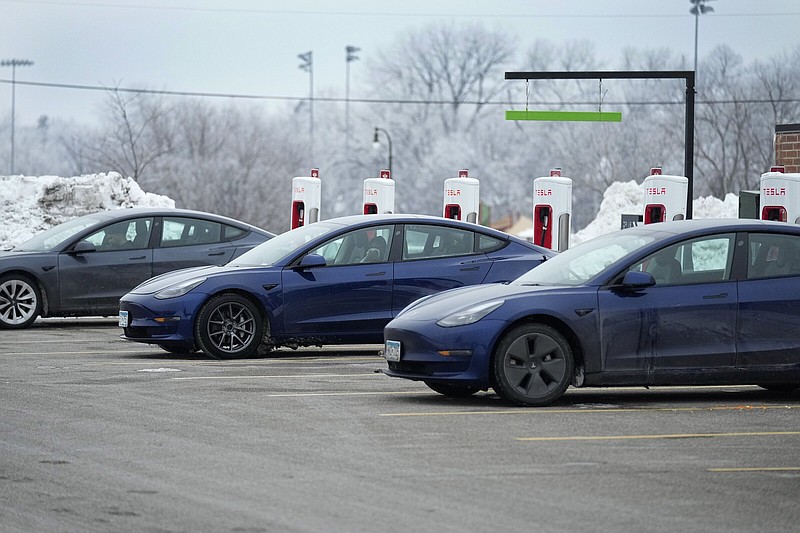The U.S. Justice Department has requested documents from Tesla related to its Autopilot and "Full Self-Driving" features, according to a regulatory filing.
But the Austin, Texas, electric-vehicle maker has cautioned that if the federal government decides to pursue enforcement, it could have a material adverse impact on its business.
"To our knowledge no government agency in any ongoing investigation has concluded that any wrongdoing occurred," Tesla said in the filing Tuesday with the Securities and Exchange Commission.
Messages were left Tuesday seeking comment from the Justice Department and from Tesla, which has disbanded its media relations department.
Tesla is already facing multiple investigations by the National Highway Traffic Safety Administration for problems with its two driver-assist systems, Autopilot and "Full Self-Driving."
Despite the names of the features, Tesla still says on its website that its cars can't drive themselves. Tesla drivers using "Full Self-Driving" can navigate roads in many cases, but experts say the system can make mistakes, which even CEO Elon Musk has acknowledged. "We're not saying it's quite ready to have no one behind the wheel," CEO Musk said in October.
Michael Brooks, executive director of the nonprofit Center for Auto Safety, said the Justice Department could be looking at safety issues with the systems, or it could be investigating Tesla claims that the cars can drive themselves when they can't.
"When you get the car, it really can't do everything that's been promised," Brooks said. "Tesla is putting a vehicle out on the road that is unable to perform to the capabilities claimed. Yet we have drivers relying on those promises and essentially not paying attention to the drive because they think it is more capable than it is."
The systems have been under investigation by NHTSA since June of 2016, when a driver using Autopilot was killed after his Tesla went under a tractor-trailer crossing its path in Florida.
A separate probe into Teslas that were using Autopilot when they crashed into emergency vehicles started in August 2021. At least 14 Teslas have crashed into emergency vehicles while using the Autopilot system.
Including the Florida crash, NHTSA has sent investigators to 35 Tesla crashes in which automated systems are suspected of being used. Nineteen people have died in those crashes, including two motorcyclists.
The agency also is investigating complaints that Teslas can brake suddenly for no reason.
"Full Self-Driving" went on sale late in 2015, and Musk has used the name ever since. It currently costs $15,000 to activate the system.
In 2019 he promised a fleet of autonomous robo-taxis by 2020, and Musk said in early 2022 that the cars would be autonomous that year.
Since 2021, Tesla has been beta-testing its "Full Self-Driving" feature using owners who haven't been trained on the system but are actively monitored by the company. Tesla said last month that 400,000 owners are participating.
Auto safety advocates and government investigators have long criticized Tesla's monitoring system as inadequate. Three years ago the National Transportation Safety Board listed poor monitoring as a contributing factor in a 2018 fatal Tesla crash in California. The board recommended a better system but said Tesla has not responded.
NHTSA has noted in documents that numerous Tesla crashes have occurred in which drivers had their hands on the wheel but still weren't paying attention.
The agency has said Autopilot is being used in areas where its capabilities are limited and that many drivers aren't taking action to avoid crashes despite warnings from the vehicle.
Additionally, the National Transportation Safety Board determined in 2020 that Tesla's system to ensure drivers are paying attention is inadequate and should be limited to areas where the system can safely operate.
SPONTANEOUS COMBUSTION
In an unrelated incident, a Tesla Model S "spontaneously caught fire" Saturday on a Sacramento County highway after its battery compartment overheated, local authorities said.
The car was traveling at "freeway speeds" on Highway 50 in Rancho Cordova, Calif., when it burst into flames, the Sacramento Metropolitan Fire District said.
Before it was ablaze on a roadway, the car had no known mechanical problems, the authorities said.
Fire crews used jacks to lift the white Tesla before spraying the underside of the vehicle and its battery.
"The fire was extinguished with [about] 6,000 gallons of water, as the battery cells continued to combust," the fire district said.
Photos and video from the fire district show black smoke spewing from the Tesla, while firefighters spray it down on the side of the freeway as traffic keeps flowing.
No injuries were reported.
In June, the Sacramento Metropolitan Fire District extinguished another flaming Tesla.
That car, involved in an accident, had been parked in a wrecking yard for three weeks before it suddenly caught on fire.
It took firefighters more than an hour to extinguish the flames, the fire district said.
Crews kept knocking down the blaze, but flames kept reigniting in the battery compartment, the district said. Firefighters eventually had to dig a pit in the wrecking yard, place the car inside and fill the pit with water.
According to a 2016 Model S emergency response guide by Tesla, battery fires can take up to 24 hours to fully cool.
"When a fire is involved, consider the entire vehicle energized and DO NOT TOUCH any part of the vehicle," the guide states.
Information for this report was contributed by staff of The Los Angeles Times.

